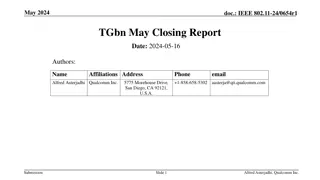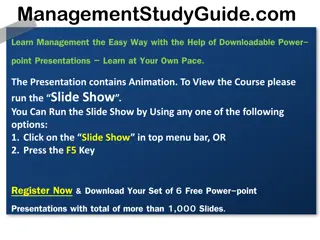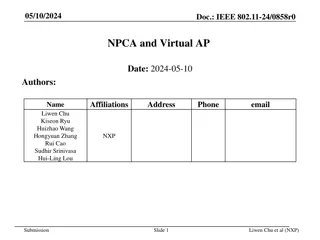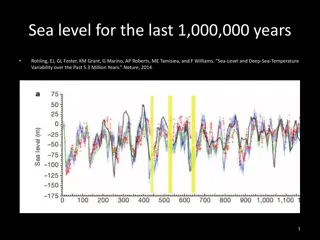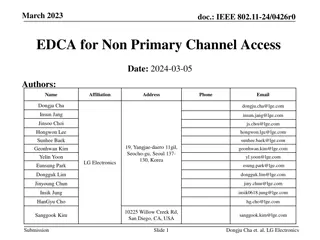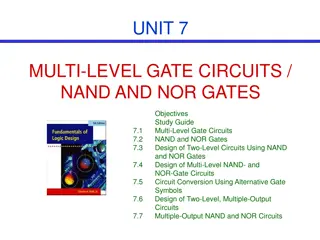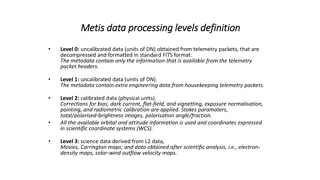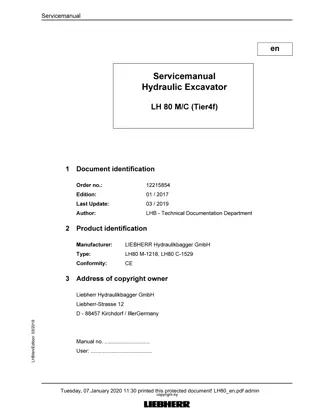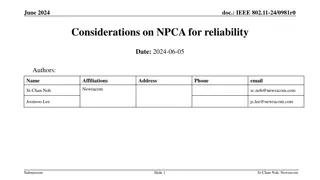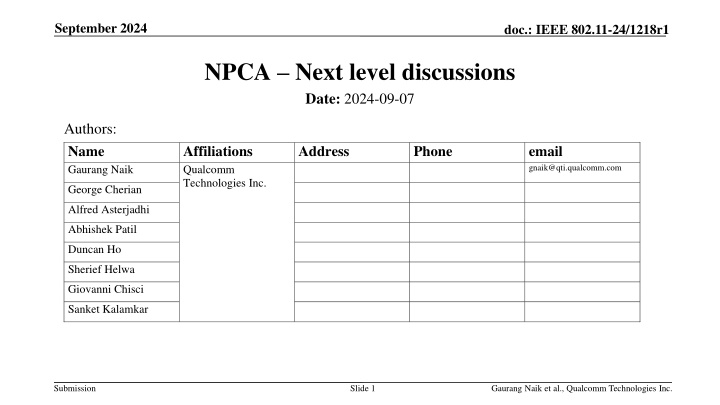
Next Level Discussions on IEEE 802.11-24 NPCA in UHR
Delve into the advanced discussions surrounding the Non-Primary Channel Access (NPCA) feature in IEEE 802.11-24, specifically focusing on enabling communication between APs and non-AP STAs on secondary channels in busy primary channel scenarios. Explore key aspects such as switching delays, coordination between NPCA STAs, and operational details for enhanced network efficiency.
Download Presentation

Please find below an Image/Link to download the presentation.
The content on the website is provided AS IS for your information and personal use only. It may not be sold, licensed, or shared on other websites without obtaining consent from the author. If you encounter any issues during the download, it is possible that the publisher has removed the file from their server.
You are allowed to download the files provided on this website for personal or commercial use, subject to the condition that they are used lawfully. All files are the property of their respective owners.
The content on the website is provided AS IS for your information and personal use only. It may not be sold, licensed, or shared on other websites without obtaining consent from the author.
E N D
Presentation Transcript
September 2024 doc.: IEEE 802.11-24/1218r1 NPCA Next level discussions Date: 2024-09-07 Authors: Name Gaurang Naik Affiliations Qualcomm Technologies Inc. Address Phone email gnaik@qti.qualcomm.com George Cherian Alfred Asterjadhi Abhishek Patil Duncan Ho Sherief Helwa Giovanni Chisci Sanket Kalamkar Submission Slide 1 Gaurang Naik et al., Qualcomm Technologies Inc.
September 2024 doc.: IEEE 802.11-24/1218r1 Recap Non-Primary Channel Access (NPCA) feature in UHR enables an AP and a non-AP STA to communicate on a nonprimary channel when the primary channel is busy due to OBSS traffic TGbn has agreed to the following: TGbn defines a mode of operation that enables a STA to access the secondary channel while the primary channel is known to be busy due to OBSS traffic or other TBD conditions. The mode of operation shall not assume that the STA is capable to detect or decode a frame and obtain NAV information of the secondary channel concurrently with the primary channel. A BSS shall only have a single NPCA primary channel (name TBD) on which the STA contends while the primary channel of the BSS is known to be busy due to OBSS traffic or other TBD conditions. Submission Slide 2 Gaurang Naik et al., Qualcomm Technologies Inc.
September 2024 doc.: IEEE 802.11-24/1218r1 Introduction When an OBSS transmission is detected on the BSS primary, NPCA STAs will switch to the NPCA Primary channel and will contend to initiate a TXOP To ensure coordinated operation on the NPCA Primary, the following details must be specified: When can an NPCA transmitter initiate a TXOP after switching? How does the transmitter contend on the NPCA Primary channel? Which subchannels can the transmitter use after gaining access? Are there ways to improve coordination between two peer NPCA STAs? In this contribution, we provide the details on the above aspects of NPCA Submission Slide 3 Gaurang Naik et al., Qualcomm Technologies Inc.
September 2024 doc.: IEEE 802.11-24/1218r1 Switching delay A switch from the Primary channel to the NPCA Primary channel will incur a delay Refer to this as the NPCA Switching delay Similarly, a switch from the NPCA Primary channel to the BSS Primary channel will also incur a delay Refer to this as the NPCA Switch back delay The spec must allow the NPCA STAs to signal these delays to its peer As an example, AP advertises its switching delays in Management frame(s) that it transmits, and a non- AP STA provides its switching/switch back delays when it exchanges frames for enabling NPCA mode Each NPCA STA must honor the switching and switch back delay of its peer when initiating a TXOP on the NPCA Primary channel Which implies that after switching, the NPCA transmitter shall not transmit a frame to the NPCA receiver until the receiver s NPCA Switching delay has elapsed Note: the delay time must be applied after a reference switch time which is TBD and needs to be defined Submission Slide 4 Gaurang Naik et al., Qualcomm Technologies Inc.
September 2024 doc.: IEEE 802.11-24/1218r1 Contention on NPCA Primary channel Two successive switches to the NPCA Primary channel may be separated by large gaps During this time, NPCA STAs Will not contend on the NPCA Primary channel Are not required to be aware of OBSS activity (if any) on the NPCA Primary channel Therefore, an NPCA STA doesn t have to maintain the contention parameters for the NPCA primary in the same manner as the BSS s primary channel (which it will be accessing more often). For simplicity, we propose: NPCA STAs do not need to maintain the backoff state for the NPCA Primary channel after switching back to the primary channel Instead, every time the NPCA STA switches to the NPCA Primary channel, it sets the CW to a certain value and picks a new backoff counter value Submission Slide 5 Gaurang Naik et al., Qualcomm Technologies Inc.
September 2024 doc.: IEEE 802.11-24/1218r1 Subchannels used for NPCA transmissions After gaining the right to initiate a TXOP on the NPCA Primary channel, the NPCA STA can combine additional idle 20 MHz subchannels However, these 20 MHz subchannels must satisfy the following conditions: Include the NPCA Primary channel Be within the AP s BSS bandwidth Must not occupy the channels within the bandwidth of the OBSS transmission on the BSS Primary channel Must not include any channel that the AP has punctured using the Disabled Subchannel Bitmap To utilize the entire remaining bandwidth, puncturing may be required E.g., if OBSS BW is 40 MHz in a 160 MHz BSS, utilizing the remaining 120 MHz requires puncturing However, if an immediate response is required, per 11be rules, this can be achieved only by soliciting TB PPDUs Further discussion is needed on whether a frame that does not solicit TB PPDUs can puncture subchannels beyond those that are indicated in the Disabled Subchannel Bitmap Submission Slide 6 Gaurang Naik et al., Qualcomm Technologies Inc.
September 2024 doc.: IEEE 802.11-24/1218r1 Trigger frames signaling in NPCA (1/2) When NPCA STA switches to NPCA Primary channel, It performs ED, PD, and contends for access on NPCA Primary channel Monitors for incoming PPDUs from peer NPCA STA on the NPCA Primary channel Thus, during an NPCA opportunity, the NPCA Primary channel serves as a temporary primary channel for the NPCA STA In a triggered UL OFDMA transmissions, the RU assigned to the STA is with respective to the primary channel. For example, B1-B7 of RU Allocation indicate the RU assigned to the non-AP STA within an 80 MHz block of the BSS bandwidth, wherein the 80 MHz block is identified by B0 and PS160 fields However, when operating on the NPCA primary channel there is an ambiguity as to which is the reference primary channel. Since the NPCA primary channel acts as a temporary primary channel, we propose to use the NPCA Primary channel as the reference primary for triggered UL OFDMA operation Submission Slide 7 Gaurang Naik et al., Qualcomm Technologies Inc.
September 2024 doc.: IEEE 802.11-24/1218r1 Trigger frames signaling in NPCA (2/2) View at AP There may be instances where an OBSS transmissions is detected by the non-AP STA but not detected by the AP In such a scenario, the AP might transmit a Trigger frame spanning the entire BSS bandwidth, which includes the NPCA Primary channel The non-AP STA that has switched to the NPCA Primary channel, upon decoding the Trigger frame, might infer the wrong RU and respond in the wrong RU Can be resolved by including an explicit indication when Trigger frame is transmitted via the NPCA Primary channel The non-AP STA can combine the explicit indication with the RU Allocation and respond in the correct RU Trigger frame (non-HT dup) Intended RU RU: B0=1 PS160=0 Transmitted via Pri20. RU alloc w.r.t Pri20. Expected response View at 320 MHz STA Inferred RU Trigger frame (non-HT dup) Response transmitted in the wrong RU NPCA Switch RU: B0=1 PS160=0 OBSS Pri20 Received on NPCA-Pri20. Infers RU alloc w.r.t NPCA-Pri20. Submission Slide 8 Gaurang Naik et al., Qualcomm Technologies Inc.
September 2024 doc.: IEEE 802.11-24/1218r1 Improving coordination in NPCA (1/2) L1 PPDU 1 Ack There can be loss of coordination between the NPCA AP & NPCA non-AP STA if both AP and non-AP STA contend and transmit For example, due to hidden node or the asymmetric view problem among other issues Hidden node problem: When one peer observes OBSS but other does not If AP does not observe OBSS, client s EDCA transmission would be wasted If client does not observe OBSS, TXOP is still successful as long as one NPCA STA responds to the AP Asymmetric view: When NPCA AP and non-AP STA observe different OBSS PPDU/TXOP The duration for which BSS Primary channel is Busy is different at the two NPCA peers (see adjoining figure) Client s EDCA transmission might initiate TXOP for a duration longer than what is Busy at the AP Causing AP to become unavailable on the BSS Primary channel for a portion of time NPCA AP NAV2 RTS CTS PPDU 2 Ack Submission Slide 9 Gaurang Naik et al., Qualcomm Technologies Inc.
September 2024 doc.: IEEE 802.11-24/1218r1 Improving coordination in NPCA (2/2) Proposal: Define a mode under NPCA where NPCA non-AP STAs do not use untriggered UL transmissions In both problems discussed in the previous slide, it is the AP s view that matters If AP is performing frame exchanges on NPCA Primary channel beyond how long its BSS Primary channel is Busy, legacy non-AP STA can have a performance impact Therefore, it is more efficient for the AP to initiate TXOP as per what it observes on the BSS Primary channel Enabling a mode where NPCA non-AP STAs do not use untriggered UL transmissions may lower cases of coordination loss between NPCA peers Submission Slide 10 Gaurang Naik et al., Qualcomm Technologies Inc.
September 2024 doc.: IEEE 802.11-24/1218r1 Summary NPCA can improve spectral utilization by utilizing unused secondary channels when the primary channel is Busy However, switching and transmissions on the NPCA Primary channel must be coordinated to maximize these gains In this contribution we presented details on the following aspects: When is the earliest that an NPCA transmitter can initiate a TXOP after switching How the transmitter contends on the NPCA Primary channel Which channels can be used by the NPCA transmitter after it gains access How a trigger-only mode under NPCA improves coordination between peer NPCA STAs Submission Slide 11 Gaurang Naik et al., Qualcomm Technologies Inc.
September 2024 doc.: IEEE 802.11-24/1218r1 Straw Polls 1. Do you agree that an NPCA STA shall indicate the following to its peer NPCA STA? NPCA switching delay time it needs to switch from the BSS Primary channel to the NPCA Primary channel NPCA switch back delay time it needs to switch from the NPCA Primary channel to the BSS Primary channel Submission Slide 12 Gaurang Naik et al., Qualcomm Technologies Inc.
September 2024 doc.: IEEE 802.11-24/1218r1 Straw Polls 2. Do you agree with the following: An NPCA STA shall initiate frame exchange on the NPCA Primary channel with an NPCA Initial Control Frame in the non-HT PPDU or non-HT duplicate PPDU format using a rate of 6 Mb/s, 12 Mb/s, or 24 Mb/s Details on NPCA ICF are TBD Submission Slide 13 Gaurang Naik et al., Qualcomm Technologies Inc.
September 2024 doc.: IEEE 802.11-24/1218r1 Straw Polls 3. Do you agree that an NPCA STA shall initiate a TXOP on the NPCA Primary channel following the rules defined in 10.23.2.2 (EDCA backoff procedure) and 10.23.2.4 (Obtaining an EDCA TXOP) with the following exception: Every time the STA switches to the NPCA Primary channel, it shall initialize CW_NPCA[AC] to TBD value and pick a new backoff counter (BO_NPCA) randomly between 0 and CW_NPCA[AC]. QSRC_NPCA[AC] shall be set to 0. NOTE Baseline EDCA procedure is followed on the BSS Primary channel. The values of CW_NPCA and BO_NPCA are discarded by the NPCA STA when it switches back to the BSS Primary channel. Submission Slide 14 Gaurang Naik et al., Qualcomm Technologies Inc.
September 2024 doc.: IEEE 802.11-24/1218r1 Straw Polls 4. Do you support that after an NPCA STA has gained the right to initiate a TXOP on the NPCA Primary channel, it can transmit on a set of channels that: Includes the NPCA Primary channel, and are within the AP s BSS bandwidth, and do not include the channels in the bandwidth occupied by the OBSS traffic that caused the NPCA STA to switch from the BSS primary channel to the NPCA primary channel, and do not include the channels that are indicated as punctured in the Disabled Subchannel Bitmap subfield in the EHT Operation element, It is TBD whether a frame that does not solicit TB PPDUs can puncture 20 MHz subchannels not indicated as punctured in the Disabled Subchannel Bitmap subfield of the EHT Operation element Submission Slide 15 Gaurang Naik et al., Qualcomm Technologies Inc.
September 2024 doc.: IEEE 802.11-24/1218r1 Straw Polls 5. Do you agree to the following: When soliciting an UL TB PPDU on the NPCA Primary channel, the NPCA AP shall signal the RU index considering the NPCA Primary channel as the reference primary channel The Trigger frame soliciting the TB PPDU shall explicitly indicate that it is transmitted via the NPCA Primary channel (details TBD) Submission Slide 16 Gaurang Naik et al., Qualcomm Technologies Inc.
September 2024 doc.: IEEE 802.11-24/1218r1 Straw Polls 6. Do you agree to define a mode of operation in NPCA where the NPCA non-AP does not use untriggered UL transmissions on the NPCA primary channel This mode can be enabled/disabled by the AP Whether the mode is for all associated non-APs or per non-AP is TBD TBD whether MU EDCA parameters mechanism is used for this or not Submission Slide 17 Gaurang Naik et al., Qualcomm Technologies Inc.
September 2024 doc.: IEEE 802.11-24/1218r1 References [1] M. Park, et al., 11-24/0495r0: Non-Primary Channel Access (NPCA) Follow Up Submission Slide 18 Gaurang Naik et al., Qualcomm Technologies Inc.




